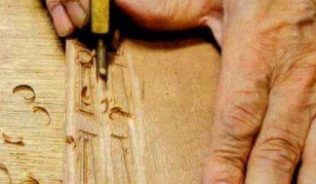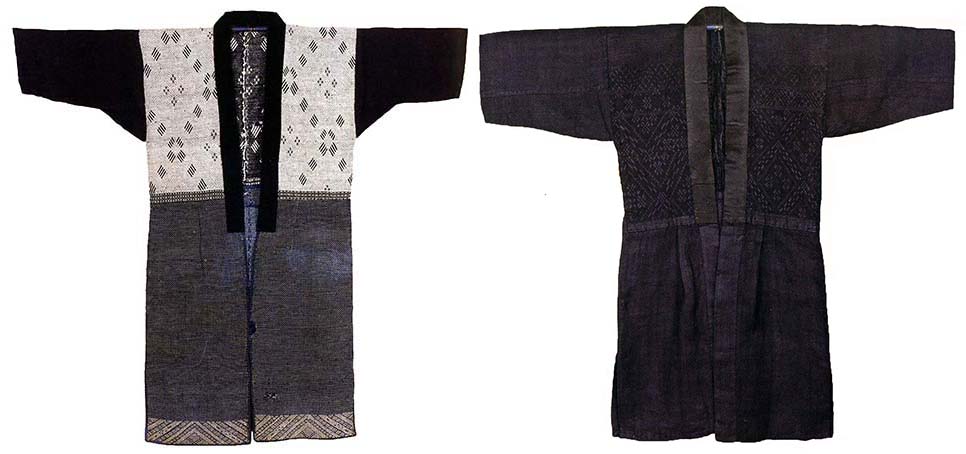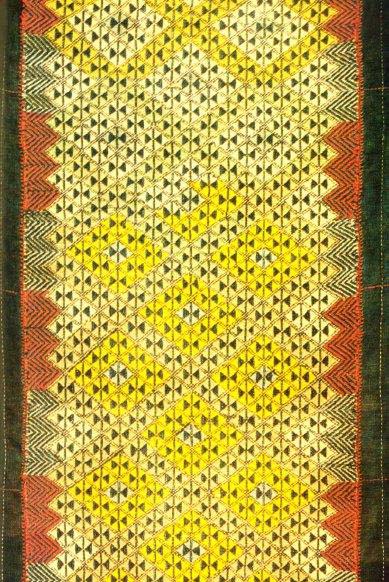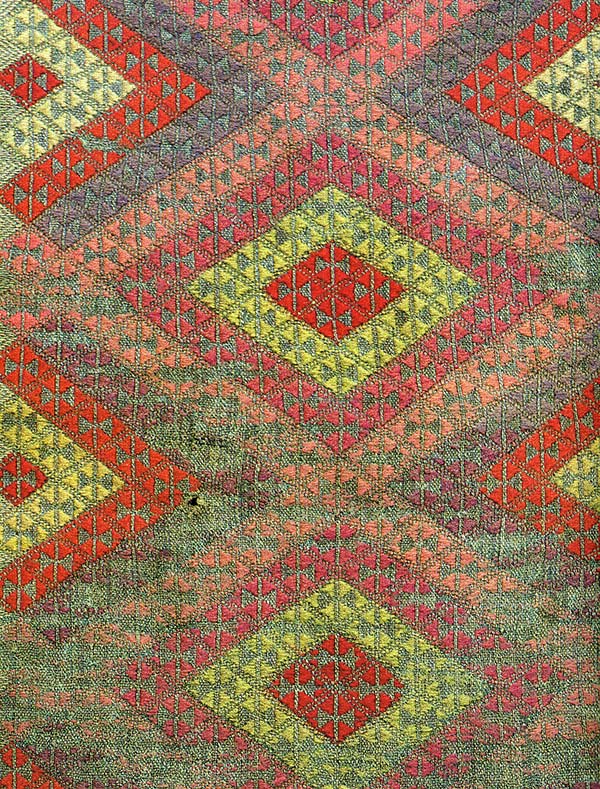Japanese needle works, Sashiko 3 – Nanbu hishi-zashi
Nanbu hishi-zashi apron made in Nanbu, Aomori. Collection of Ogawarako Minzoku Museum, Aomori (this museum is currently closed).
Both Tsugaru kogin-zahis and Nanbu hishi-zashi were made for the same functional purpose, making their hemp garments durable and warm by covering them with stitches, but also there are some differences between them, and I will write about them, too.
 Nanbu is located in the Eastern Aomori separated by the Mount Hakkouda from Tsugaru. It is not a heavy snowfall area, like Tsugaru, but cooler throughout a year because of the north wind coming from the Okhotsk Sea. Although Nanbu was known for its horse breeding industry, their dry field were often damaged by cold summers and their lives were not easy.
Nanbu is located in the Eastern Aomori separated by the Mount Hakkouda from Tsugaru. It is not a heavy snowfall area, like Tsugaru, but cooler throughout a year because of the north wind coming from the Okhotsk Sea. Although Nanbu was known for its horse breeding industry, their dry field were often damaged by cold summers and their lives were not easy.
Nanbu hishi-zashi was dyed with lighter indigo compared to Tsugaru kogin-zashi
Having been faced with a disadvantaged farming condition, peasants in Nanbu became practical and thrifty. They dyed their hemp garments at home sparing expensive indigo dyes as much as possible. That is why Nanbu hishi-zashi garments are in light blue as contrasted with Tsugaru kogin-zashi that was dyed with dark blue. I personally like the Nanbu shishi-zashi more; I think the combination of pale blue and black for their sleeves looks stylish. Please compare the difference between Nanbu hishi-zashi (the upper two kimonos below) and Tsugau kogin-zashi (the lower two kimonos below). Which do you like better?
 Nanbu hishi-zashi kimonos design with hemp-cotton combination styles (hemp was dyed with the light blue and cotton is in black color). Please look at the photo of two women wearing combination style in the photo below. Collection of Ogawarako minzoku museum (this museum in currently closed)
Nanbu hishi-zashi kimonos design with hemp-cotton combination styles (hemp was dyed with the light blue and cotton is in black color). Please look at the photo of two women wearing combination style in the photo below. Collection of Ogawarako minzoku museum (this museum in currently closed)
Tsugaru kogin-zashi kimonos, collection of Amuse Museum
Using cotton fabrics that became available for the peasants after the Meiji Restoration*
The history of Nanbu hishi-zashi is a newer than Tsugaru kogin-zashi. Tsugaru kogin-zashi was started to be made at the end of 18th century applying cotton threads on hemp garments, because peasants in Aomori were not allowed to used cotton fabrics during the Edo period (1603- 1868). On the other hand, Nanbu hishi-zasi had been developed in the late 19th century after the Meiji Restoration (1868-)* during the time when Japanese people started to be westernized. Peasants were liberated from the control of the Shogunate and could buy cotton fabrics from outside of Aomori. This is why Nanbu hishi-zashi garments had cotton liner, hemp-cotton combination styles. They cherished the valuable used cotton fabrics and tried to apply them most beautifully and efficiently.
*Meiji Restoration: In 1868, the last Edo Shogun returned political power to the emperor, and the emperor began to rule once again. Then feudal policies such as the land-owning and class systems were abolished and a new constitution was established. Meiji period ended in 1912.
Women wearing Nanbu hishi-zashi hemp-cotton combination kimono, photo taken at a photo studio in the beginning of Taisho period (1912-1926)
Beautiful apron stitched with colored wool yarn imported from abroad
My favorite Nanbu hishi-zashi pieces are the ones stitched with colored wool yarn imported from aboard. Those wool yarns became available in Aomori in the Taisho period (1912-1926), and the peasants in Nanbu bought waste yarn a little at a time to stitch on their Apron. The photo below is the women wearing Nanbu hishi-zahsi aprons.
Nanbu hishi-zashi fabrics, collection of Ogawarako Minzoku Museum, Aomori (this museum is currently closed).
The photo was taken in a photo studio in the late Taisho period (1912-1926)
I think it is wonderful that the poor peasants women invented those beautiful sashiko art with very limited materials. They were really creative and passionate and must be very proud of themselves.

Tetsuo Koyama’s woodblock print dyeing technique
I will write about Tetsuo Koyama’s woodblock print dyeing technique. Tetsuo will bring traditional dyeing tools and materials for his ...










Leave a Reply